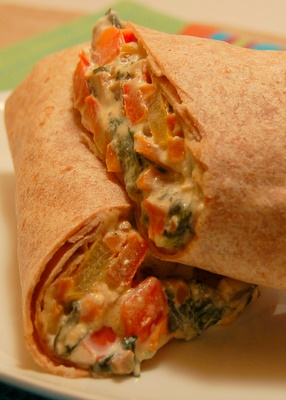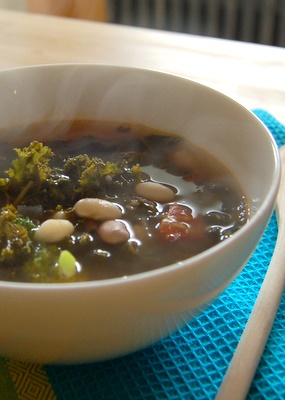 "What can I get for you, Helen?" asked Carl.
"What can I get for you, Helen?" asked Carl."I think I'll get monkfish," I said. I am not sure if it was my desire to try something new or my recent craving for anything that works with mashed potatoes.
"How are you cooking it?" he asked.
"I'll keep it on the bone and try a braising method with an osso buco type sauce," I told Carl. You see, monkfish is not on my regular list of fish. I don't care for that "pooh man's lobster" texture that people rave about. If I want lobster, I'll buy one. In my experience, all the traditional ways of cooking fish (pan searing, broiling, grilling, roasting, poaching, and steaming) results in a monkfish that's rubbery. But I had reasons to believe that there is hope. I had a fabulous dish of a whole braised monkfish tail in a restaurant once, and that's what I was thinking of recreating.
Carl surveyed the scene of whole monkfish tails and shook his head.
"These are no good," he said. "They'd be fine to fillet, but for a good on the bone braise... I know what you need."
He disappeared to the back room and came back a minute later with a whole monster of a fish. I've seen a whole monkfish before, but every time I come face to face with this creature, I shudder. Its mouth is bigger than its body and packed with sharp teeth. Its eyes always seem to be looking at me and saying "If only I was still alive, I'd make a nice meal out of you!"
Carl plopped the helpless beast on the counter and told his helper Isaiah to cut me a piece that is closest to the head. I've never seen this part of monk sold in stores. I thought I was lucky when I saw the original monk tails still attached to the bone. I don't understand why most stores fillet them. The monk tastes so much juicier when it's still on the bone and once it's cooking, filleting it is a breeze -- the one thick bone pops right now. But this gorgeous piece that Isaiah cut for me truly looked like a veal shank.
I brought it home and cooked it exactly like I cook osso buco with veal shanks, but reducing the cooking time from several hours to just 30 minutes. The results were amazing. It was the most delicate and moist monkfish we've ever had.
"Was it this good in the restaurant?" asked Jason.
"If they bought their monk from the New Deal, it would have been," I said.
Monkfish Osso Buco
Buying monkfish: To do this dish justice, you need bone-in monkfish. Unlike other fish, the only part of monk that is edible is its tail. If you are lucky enough to have your fishmonger cut a whole fish to order for you, ask him for the thickest part of the tail (closest to the head) and instruct him to cut it into 1.5 inch steaks. If you ended up with a thin part of the tail, just leave it whole.
Removing the membrane: Even if your fishmonger removes the skin off the monk, you still need to remove the membrane that covers the flesh of the monk. It looks like a translucent sack and usually has tiny black dots. Remove it with a boning knife like you would remove the silver skin off meat. You have to be thorough and remove absolutely all of it as it gets chewy when cooked.
Trussing the steaks: If you got nice thick steaks, you should truss them with kitchen twine (that's fancy word for tie it up). Depending on its thickness, you might need one or two strings. Remove the string before serving the dish. If you got a thinner end of the tail, don't worry about trussing it.
Fish substitutions: halibut steaks
Serves 4
2 Lb bone-in monkfish tail (prepared according to above instructions)
4 strips of bacon, cut into 1/2 inch pieces
1 large yellow onion, diced
3 medium carrots, peeled and diced
1 celery rib, peeled and diced
10 whole garlic cloves, unpeeled
2 tsp finely minced rosemary and/or thyme
14.5 oz can diced tomatoes, drained
1/2 cup dry white wine
All-purpose flour for dredging monkfish
1 Tbsp canola or olive oil
Salt and black pepper
- Preheat the oven to 250F.
- Set a large skillet over medium heat. Add the bacon in one layer and cook stirring occasionally until nicely browned and the fat is rendered, 5-8 minutes.
- Add onion, carrots, celery, whole garlic cloves, and a generous pinch of salt. Cook over medium heat, stirring occasionally, until the vegetables are tender and golden brown, 10-12 minutes.
- Add the herbs, tomatoes, and wine. Bring to a boil. Cover, reduce heat to low, and simmer for 15 minutes. While the sauce is cooking, prepare the monkfish.
- Dry monkfish well on paper towels. Season it all over with salt and pepper, and dredge in flour, shaking off access. Set a large non-stick or cast-iron skillet over high heat. When hot, add the oil and swirl the skillet to coat. Place the fish in the pan without crowding and cook on all sides until golden brown (1-2 minutes per side). Remove monkfish from the pan and set aside.
- Taste the sauce and correct seasoning. Place monkfish in the pan with the sauce and spoon the sauce on top of it. Cover the skillet and place in the oven for about 18 minutes per inch of thickness. Start testing for doneness 5 minutes before the estimated cooking time is up. Monkfish does not flake like other fish, so it's hard to separate the flakes and look inside. The most reliable way to test it, is to insert an instant read thermometer into the thickest part (but not next to the bone). The fish is done when it's at 140F. If you don't have an instant read thermometer handy, try to separate the flesh from the bone -- if you encounter no resistance, monkfish is done (this can be a little tricky if your steaks are tied up).
- Serve immediately with the sauce and some good crusty bread for dipping. Mashed potatoes are also quite heavenly with this dish.

 Before I get to the dish in the picture, let me share the news that have been overflowing our family with joy since yesterday. Jason (my husband) has defended his Ph.D. thesis. It's hard to describe what this feels like. The goal towards which I saw him work for so many years is finally accomplished! Jason did a wonderful job with his defense talk yesterday, and after a few nerve racking minutes of closed-door committee meeting, it was official that we should break out the good champagne (In case anyone is curious, it was Dom Pérignon 1996 :)
Before I get to the dish in the picture, let me share the news that have been overflowing our family with joy since yesterday. Jason (my husband) has defended his Ph.D. thesis. It's hard to describe what this feels like. The goal towards which I saw him work for so many years is finally accomplished! Jason did a wonderful job with his defense talk yesterday, and after a few nerve racking minutes of closed-door committee meeting, it was official that we should break out the good champagne (In case anyone is curious, it was Dom Pérignon 1996 :) The passion I feel for this dish is not unlike the passion Americans (myself included) feel for burgers. What can be simpler? The whole thing has just a handful of ingredients -- pasta type dough wrapped around creamy potato and sautéed onion filling. Yet, there are so many subtle nuances that can elevate such dishes to cult-like standing. With burgers, it's all about perfecting the balance between charring the outside while keeping the inside rare enough to explode with juices that leak to your elbows as you take a bite. With pierogies, it's all about making the dough that's elastic and supple enough to provide a bare hint of resistance as you take a bite. Both have to be seasoned to perfection -- under-salted ground beef or potatoes taste like "blah" and are the first give away of inexperienced cook.
The passion I feel for this dish is not unlike the passion Americans (myself included) feel for burgers. What can be simpler? The whole thing has just a handful of ingredients -- pasta type dough wrapped around creamy potato and sautéed onion filling. Yet, there are so many subtle nuances that can elevate such dishes to cult-like standing. With burgers, it's all about perfecting the balance between charring the outside while keeping the inside rare enough to explode with juices that leak to your elbows as you take a bite. With pierogies, it's all about making the dough that's elastic and supple enough to provide a bare hint of resistance as you take a bite. Both have to be seasoned to perfection -- under-salted ground beef or potatoes taste like "blah" and are the first give away of inexperienced cook. These are no ordinary veggie wraps. What makes them so special is the synergy between the ingredients. The veggie juices, with a strong hint of mushrooms and feta, melt into yogurt. The yogurt melts into hummus. And all this goodness fills a warm whole wheat wrap with savory deliciousness. Meat and fish have not been my best friends lately. It's very not like me, but pregnancy can do these things to people. I've been having terrible carb cravings and trying to find creative ways to satisfy them while eating healthy. Soups were great, but after 3 weeks, even I can get tired of them. That's when the veggie wraps came to the rescue. They have it all -- carbs from the wrap, protein from hummus, calcium from yogurt, feta, and spinach, and tons of fiber from all these veggies and legumes.
These are no ordinary veggie wraps. What makes them so special is the synergy between the ingredients. The veggie juices, with a strong hint of mushrooms and feta, melt into yogurt. The yogurt melts into hummus. And all this goodness fills a warm whole wheat wrap with savory deliciousness. Meat and fish have not been my best friends lately. It's very not like me, but pregnancy can do these things to people. I've been having terrible carb cravings and trying to find creative ways to satisfy them while eating healthy. Soups were great, but after 3 weeks, even I can get tired of them. That's when the veggie wraps came to the rescue. They have it all -- carbs from the wrap, protein from hummus, calcium from yogurt, feta, and spinach, and tons of fiber from all these veggies and legumes. I just finished reading
I just finished reading  Please God, let me finish this post without getting nauseous.
Please God, let me finish this post without getting nauseous.